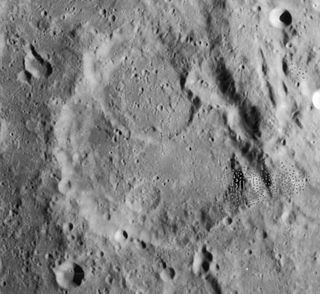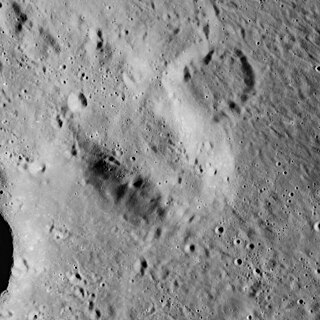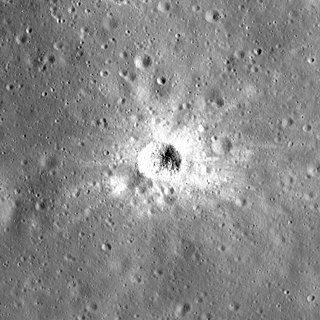
Mare Marginis is a lunar mare that lies on the very edge of the lunar nearside. The selenographic coordinates of this feature are 13.3° N, 86.1° E, and the diameter is 358 km.

Mare Nectaris is a small lunar mare or sea located south of Mare Tranquillitatis southwest of Mare Fecunditatis, on the near side of the Moon. Montes Pyrenaeus borders the mare to the east and Sinus Asperitatis fuses to its northwestern edge. It is 84,000 square kilometers in size.

Plinius is a prominent lunar impact crater on the border between Mare Serenitatis to the north and Mare Tranquilitatis to the south. Its diameter is 41 km. The crater is named after the Roman natural scientist and author Pliny the Elder. To the south-southeast of Plinius is the crater Ross, and to the northeast is Dawes. Just to the north is a system of rilles named the Rimae Plinius and touching it is the Brackett crater which is more than a crater diameter north. At the northwest edge of the rille is the Promontorium Archerusia, a cape off the western rim that encloses the Mare Serenitatis.

Ibn-Rushd is a lunar impact crater located to the northwest of the larger crater Cyrillus. To the northwest is the crater Kant and to the north is Mons Penck, a mountain promontory. The crater is somewhat eroded with age, and the southern rim is overlain by a pair of smaller craters named Cyrillus B and C. The crater floor is relatively flat, and lacks a central peak. In 1976 the crater was named after Ibn Rushd, the 12th-century Muslim polymath from the Islamic Spain, whose many scientific accomplishments included analysis of the lunar surface. Prior to that, it was identified as Cyrillus B.

Catharina is an ancient lunar impact crater located in the southern highlands. It was named after Saint Catherine of Alexandria. It lies in a rugged stretch of land between the Rupes Altai scarp to the west and Mare Nectaris in the east. To the west-northwest is the crater Tacitus, and the lava-flooded Beaumont lies to the east along the shore of Mare Nectaris. To the south-southeast is Polybius.

Burnham is a small crater located to the southeast of the crater Albategnius, in a relatively smooth area of the lunar surface. It was named after American astronomer Sherburne W. Burnham. To the southwest is Vogel.

Carrel is a small lunar crater on the Mare Tranquillitatis. It has a somewhat distorted appearance, having a slight protruding bulge in the northwest rim. The interior is somewhat irregular, with ridges and some slumped material. This crater lies across a ridge in the surface of the mare.

Proclus is a young lunar impact crater located to the west of the Mare Crisium, on the east shore of the Palus Somni. Its diameter is 27 km. It was named after 5th century Greek mathematician, astronomer and philosopher Proclus.

Atlas is a prominent lunar impact crater that is located in the northeast part of the Moon, to the southeast of Mare Frigoris. Just to the west is the slightly smaller but still prominent crater Hercules. Northeast of Atlas is the large crater Endymion.

Littrow is a lunar impact crater that is located in the northeastern part of the Moon's near side, on the east edge of Mare Serenitatis. Its diameter is 29 km. The crater is named after Bohemian astronomer Joseph Johann von Littrow (1781–1840). Some distance to the northeast is the prominent crater Römer, while to the south is Vitruvius.

Bredikhin is a lunar impact crater that is located on the far side of the Moon. It lies just to the west of the crater Mitra, and northeast of Raimond.

Gauss is a large lunar impact crater, named after Carl Friedrich Gauss, that is located near the northeastern limb of the Moon's near side. It belongs to a category of lunar formations called a walled plain, meaning that it has a diameter of at least 110 kilometers, with a somewhat sunken floor and little or no central massif. Due to its location, this crater appears considerably foreshortened when viewed from the Earth, and its visibility is affected by libration.

Hypatia is a lunar impact crater along the northwest edge of Sinus Asperitatis, a bay on the southwest edge of Mare Tranquillitatis. It was named after Egyptian mathematician Hypatia of Alexandria. The nearest crater with an eponym is Alfraganus to the west-southwest. However, farther to the south-southeast, across the lunar mare, is the prominent crater Theophilus.

Ibn Battuta is a small lunar impact crater on the Mare Fecunditatis, a lunar mare in the eastern part of the Moon's near side. It lies to the southwest of the crater Lindbergh, and northeast of the prominent Goclenius.

Kant is a small lunar impact crater that is located to the northwest of the prominent crater Cyrillus and the comparably sized Ibn Rushd. To the northwest is Zöllner, and to the east is Mons Penck. This last feature forms a mountainous promontory reaching a height of about 4 km. The crater is named after the German philosopher Immanuel Kant.

Mons Hadley is a massif in the northern portion of the Montes Apenninus, a range in the northern hemisphere of the Moon. It has a height of 4.5 km (2.8 mi) 14,764 ft (4,500 m) above the adjacent plain and a maximum diameter of 25 km at the base.

Ibn Firnas is a lunar impact crater on the far side of the Moon. Attached to the exterior of its southwestern rim is the prominent crater King. Only a few kilometers to the north, separated by a rugged stretch of terrain, is the larger crater Ostwald.

Palus Putredinis is a small lunar mare in the basin of Mare Imbrium. It stretches from the crater Archimedes southeast toward the rugged Montes Apenninus range located on the southeastern edge of Mare Imbrium. This region is a nearly level, lava-flooded plain bounded by the crater Autolycus and nearby highlands to the northeast and the foothills of the Montes Archimedes to the southwest. The selenographic coordinates are 27.4° N, 0.0° E, and it lies within a diameter of 180 kilometers (110 mi).

Mons Penck is a mountain promontory on the near side of the Moon. It lies just to the northeast of the crater Kant, to the north of Ibn-Rushd and the Rupes Altai scarp. Southeast of Mons Penck are the prominent craters Theophilus and Cyrillus.

Shioli is a small lunar impact crater that is located within the much larger Cyrillus crater on the near side of the Moon. It is a young crater with a prominent ray system.

























